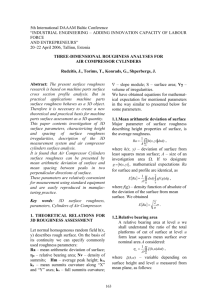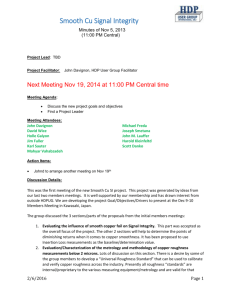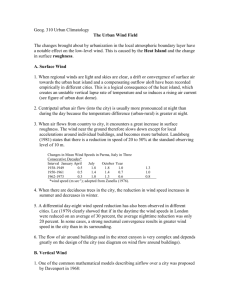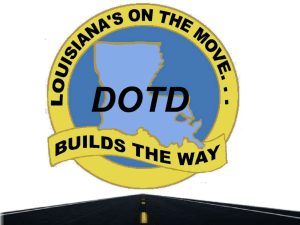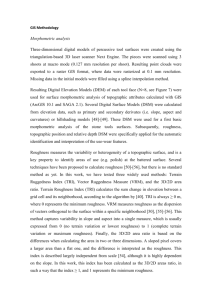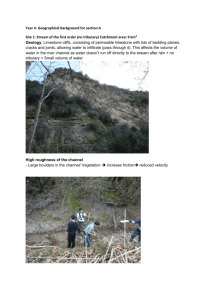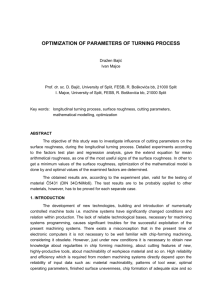30Krizbergs
advertisement
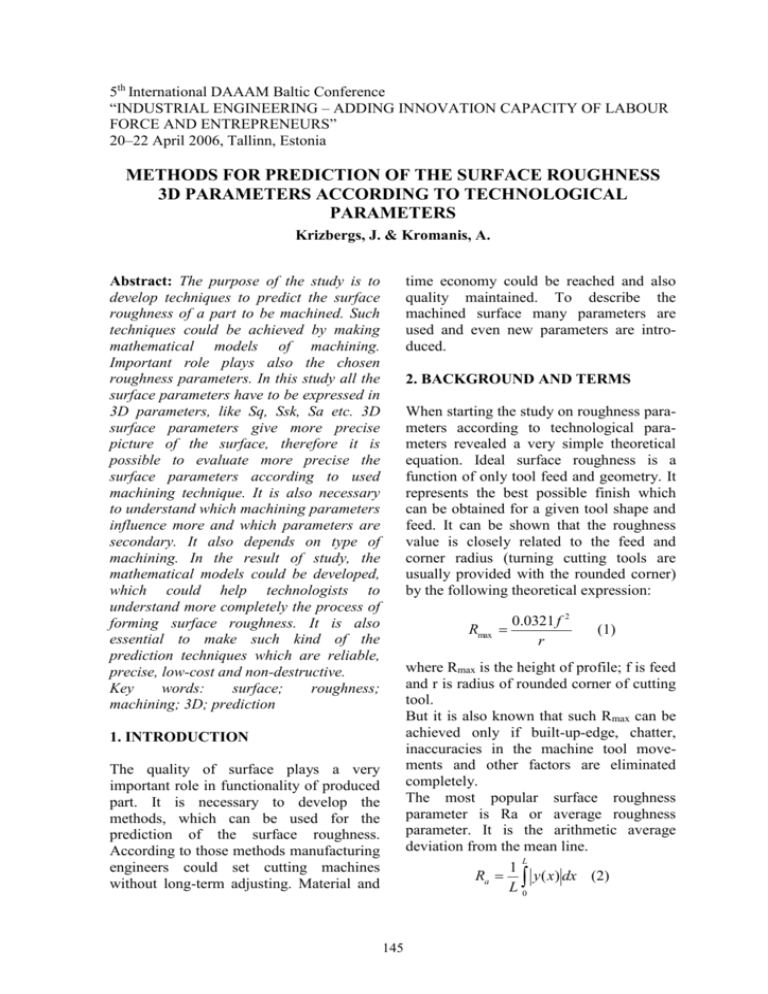
5th International DAAAM Baltic Conference “INDUSTRIAL ENGINEERING – ADDING INNOVATION CAPACITY OF LABOUR FORCE AND ENTREPRENEURS” 20–22 April 2006, Tallinn, Estonia METHODS FOR PREDICTION OF THE SURFACE ROUGHNESS 3D PARAMETERS ACCORDING TO TECHNOLOGICAL PARAMETERS Krizbergs, J. & Kromanis, A. Abstract: The purpose of the study is to develop techniques to predict the surface roughness of a part to be machined. Such techniques could be achieved by making mathematical models of machining. Important role plays also the chosen roughness parameters. In this study all the surface parameters have to be expressed in 3D parameters, like Sq, Ssk, Sa etc. 3D surface parameters give more precise picture of the surface, therefore it is possible to evaluate more precise the surface parameters according to used machining technique. It is also necessary to understand which machining parameters influence more and which parameters are secondary. It also depends on type of machining. In the result of study, the mathematical models could be developed, which could help technologists to understand more completely the process of forming surface roughness. It is also essential to make such kind of the prediction techniques which are reliable, precise, low-cost and non-destructive. Key words: surface; roughness; machining; 3D; prediction time economy could be reached and also quality maintained. To describe the machined surface many parameters are used and even new parameters are introduced. 2. BACKGROUND AND TERMS When starting the study on roughness parameters according to technological parameters revealed a very simple theoretical equation. Ideal surface roughness is a function of only tool feed and geometry. It represents the best possible finish which can be obtained for a given tool shape and feed. It can be shown that the roughness value is closely related to the feed and corner radius (turning cutting tools are usually provided with the rounded corner) by the following theoretical expression: Rmax 0.0321 f 2 r (1) where Rmax is the height of profile; f is feed and r is radius of rounded corner of cutting tool. But it is also known that such Rmax can be achieved only if built-up-edge, chatter, inaccuracies in the machine tool movements and other factors are eliminated completely. The most popular surface roughness parameter is Ra or average roughness parameter. It is the arithmetic average deviation from the mean line. L 1 Ra y ( x) dx (2) L0 1. INTRODUCTION The quality of surface plays a very important role in functionality of produced part. It is necessary to develop the methods, which can be used for the prediction of the surface roughness. According to those methods manufacturing engineers could set cutting machines without long-term adjusting. Material and 145 where L is a sampling length; y is the ordinate of the profile curve. describe the shape of the topography height distribution. Value of Ssk for example can show if the surface is honed or shaped. L Rq 1 ( y ( x)) 2 dx (3) L0 S sk Both Ra and Rq are surface profile parameters. It is already known that roughness profile parameters can not give satisfied results. Many parameters are excluded, because profile is just a small piece of all machined surface. The new parameters should be introduced. Since new metrology methods are developed, it is possible to measure the surface 3D parameters. Most popular surface 3D parameters are Sa, Sq and Ssk, and Sku. These are amplitude parameters, which are extensions of those previously employed in the 2D characterisation methods, respectively Ra, Rq, Rsk and Rku [2]. N M 1 3 ( xi ; yi ) (6) MNS q3 j 1 i 1 Sku (Kurtosis of topography height distribution) is a measure of the peakedness or sharpness of the surface height distribution. Sku is shown in equation 7. S ku 1 MNS q4 N M j 1 i 1 4 ( xi ; yi ) (7) All these surface roughness 3D parameters can be used for evaluation of the surface, but it is better to use Sa or Sq. Of course, for evaluation of honed surface it is better to use Ssk, because its better characterize honed surfaces. For example, for evaluating machining parameters in turning Sa is used, but for evaluating machining parameters in honing Ssk is used. Overall there are 14 3D parameters for measurement of surface roughness; the so called Birmingham 14. Average absolute deviation of the surface 1 N M Sa ( xi ; yi ) (4) MN j 1 i 1 where z is the height of the measured point in the coordinates x and y. Sq is the Root-Mean-Square deviation of the surface 3. SURFACE MEASUREMENT In the study for 3D surface measurements the Taylor Hobson surface measurement device is used. The name of the profilometer is Taylor Hobson Form Talysurf Intra 50. As written in the title of the publication, the 3D surface parameters are measured. For evaluation of surface roughness a Sa parameter is chosen. It was taken because it is quite similar to Ra parameter, which refers more to surface no profile roughness or surface roughness. One of the problems for using 3D surface measurements is to choose the right area for doing measurements. There are two main questions – how big should be the area of the measured surface and how big gaps should be chosen between each run of the profilometer stylus. With Ra profilometer everything is much easier – it is necessary to measure a surface by using one line on it. 1 N M 2 ( xi ; yi ) (5) MN j 1 i 1 Sq is used to distinguish between different surfaces based on height information and to monitor manufacturing stability [5]. The Sa and Sq parameters represent an overall measure of the texture comprising the surface. Sa and Sq are insensitive in differentiating peaks, valleys and the spacing of the various texture features. Nonetheless, once a surface type has been established, the Sa and Sq parameters may be used to indicate significant deviations in the texture characteristics. Ssk (Skewness of topography height distribution) is the measurement of asymmetry of surface deviations from the mean/reference plane (equation 6). This parameter can effectively be used to Sq 146 under quality control, the parameter (workpiece properties) can be considered as controllable. 4. MACHINING VARIABLES When the surface 3D parameters are chosen it is necessary to determine, which technological parameters should be considered. In this study is considered only the most traditional machining processes: turning and milling. But it can be also referred to drilling and grinding, of course with some exceptions. The final surface roughness can be considered as a sum of two technological parameters groups: e) auxiliary tooling, and used lubrication. Auxiliary tooling, for example clamping system, can be considered as controllable, if clamping process is done correctly. Clamping problems can be figure out by controlling machined parts waviness or cutting machine, for example lathe, vibration parameters. In some processes like finish hard turning lubrication or cooling liquids are not used. In such a case the factor is omitted. a) ideal surface roughness resulted from tool geometry and feed; b) natural surface roughness resulted from irregularities in the machining process. One of the main factors contributing to natural roughness is the occurrence of a built-up-edge. f) vibrations between workpiece, machine tool and cutting tool. These factors also influence the waviness and form errors of the surface. 5. ANALYSIS METHODOLOGY The next thing is to determine the factors that affect the surface finish: Various different methods have been used for evaluation of parameters of surface roughness. One of the most popular empirical methods is regression analysis. The regression analysis determines which factors and interactions are significant. Some publications have shown that it is necessary to be careful by using regression analysis, especially by choosing constants of equation. For example, the publication of Sahin and Motrcu [6] in which the constants were taken wrong and in the publication of G.C. Onwubolu [7] the correction was published. Doing research in surface prediction techniques, the following model was introduced – a functional relationship between surface roughness and the independent variables under investigation is postulated by: a) the machining variables or set up variables, which include cutting speed, feed rate, depth of cut. These parameters can be set up in advance. It means that these parameters are controllable. “Controllable” means that these parameters like cutting speed, feed and depth of cut is known – set in advance. But it does not mean that knowing these parameters it is easy to predict the surface roughness. There are many interactions between these parameters and other parameters. b) the tool geometry like nose radius, rake angle, side cutting edge angle, cutting edge. These factors depend on the tool to be chosen for exact machining process. If the tool is qualitative – predictable, then parameters are considered to be controllable. Anyway, it is necessary to keep in mind that such a factor like extensive tool wear can occur. In such a case tool geometry can not be considered as predictable parameter. Sa C f a1 v a2 d a3 H a4 r a5 (8) where Sa – surface roughness in mm, C – constant, f – feed in mm/rev., d – depth of cut in mm, H – workpiece hardness in HB (Hardness Brinell), r – tool nose radius in mm. c) workpiece and their mechanical properties. If used materials are produced 147 This is very comprehensive equation (8), because there is included also such parameters like hardness and tool nose radius. Usually, shop operator for adjusting cutting parameters starts with v, f and d. Only when he can not find suitable (optimal) cutting conditions, he tries to change material (hardness) and tool (nose radius). Concerning these assumptions we get an equation: Sa C f a1 v a2 d a3 The next type of analysis, which can be used is Analysis of Variance also known as ANOVA. Some steps in this analysis are similar to Regression analysis. Another method is Response Surface Methodology, which is known from the publication of Kopac and Bahor [1]. The next method which can be used is Taguchi Method Analysis. The Taguchi method is used to identify impact of various parameters on an output and figure out how to control them to reduce the variability in that output. The most recent method for analysing cutting factors influence on surface roughness is the Fuzzy system. Fuzzy logic is particularly attractive due too its ability to sole problems in the absence of accurate mathematical models [8]. Computational neural networks posses a number of attractive properties for modelling complex manufacturing process or system: universal function approximation capability, resistance to noisy or missing data, accommodation of multiple non-linear variables for unknown interaction, and good generalization capability [4]. (9) A logarithmic transformation converts the nonlinear form of Equation (9) into the following linear form: ln Sa ln C a1 ln f a2 ln v a3 ln d (10) For simplicity, Equation (10) is written as: y b0 b1 x1 b2 x2 b3 x3 (11) where y is the estimated surface roughness value after logarithmic transformation, b0, b1, b2, b3 are estimates of the parameters, respectively. x1, x2 and x3 are the logarithmic transformations of feed (mm/rev), cutting speed (m/min) and depth of cut (mm), respectively. After that the table of variables is made. Conducting experiment according these variables (v, f, DOC) the surface roughness 3D parameter Sa is got. The next step is regression analysis according these parameters. For regression analysis Excel or MINITAB calculation programmes can be used. From regression analysis indexes (constants) are achieved. Then the transformed linear model (equation 11) can be returned into its original nonlinear form (equation 12) as follows: 6. CONCLUSIONS This paper presents the surface roughness 3D parameters, which can be used for more precise surface evaluation than 2D surface parameters, actually profile parameters. Brief overlook of analysis methodology is given. The steps for regression analysis are shown. From practical considerations, not all machining parameters should be considered for doing prediction technique, because parameters like material hardness or tool nose radius can not be as much as changeable like cutting speed, feed rate or depth of cut by operator. Further research includes evaluation of regression analysis models. In addition the other techniques can be introduced for comparing the reliability of regression analysis. Sa C f a1 v a2 d a3 (12) where an are indexes (constants), which describe the empirical model. From that model it is possible to evaluate the influence of each parameter on the surface roughness 3D parameter. 148 7. ACKNOWLEDGEMENT 9. DATA ABOUT AUTHORS This work has been partly supported by the European Social Fund within National Programme “Support for the carrying out doctoral study programm’s and postdoctoral researches” project “Support for the development of doctoral studies in Riga Technical University”. Juris Krizbergs, Prof., Dr.Sc.ing. Riga Technical University, Institute of Mechanical Engineering Address: Ezermalas 6, LV – 1006, Riga, Latvia Phone: +371 9464628 e-mail: juris.krizbergs@rtu.lv 8. REFERENCES Artis Kromanis, M.Sc. Riga Technical University, Institute of Mechanical Engineering Address: Ezermalas 6, LV – 1006, Riga, Latvia Phone: +371 6779672; e-mail: artis.kromanis@gmail.com 1. Bahor, M., Kopac, J. Interaction of the workpiece material’s technological past and machining parameters on the desired quality of the product surface roughness. Journal of Materials Processing Technology, Vol. 109, pp. 105-111, 2001. 2. Blunt, L., Stout K. J. Three-dimensional Surface Topography. Penton Press, London, 2000. 3. Blunt, L., Xiangqian J. Advanced Techniques for Assessment Surface Topography. Kogan Page Science, London, 2003. 4. Coit, D. W., Jackson, B. T., and Smith, A. E. Static neural network process models: considerations and case studies. International Journal of Production Research, 36(11), 2953-2967, 1998 5. Exploring Surface Texture. A fundamental guide to the measurement of surface finish. Taylor Hobson Limited, England, 2000 (c). 6. Motrcu, A. R., Sahin, Y. Surface roughness prediction model in machining of carbon steel by PVD coated cutting tools. American Journal of Applied Sciences, Vol. 1(1), pp. 12-17, 2004. 7. Onwubolu, G. C. A note on “Surface roughness prediction model in machining of carbon steel by PVD coated cutting tools”. American Journal of Applied Sciences, Vol. 2(6), pp. 1109-1112, 2005. 8. Samhouri M. S., Surgenor, B. W. Surface roughness in grinding: on-line prediction with adaptive neuro-fuzzy inference system. Transaction of NAMRI/SME, Vol. 33, pp. 57-64, 2005. 149 150

